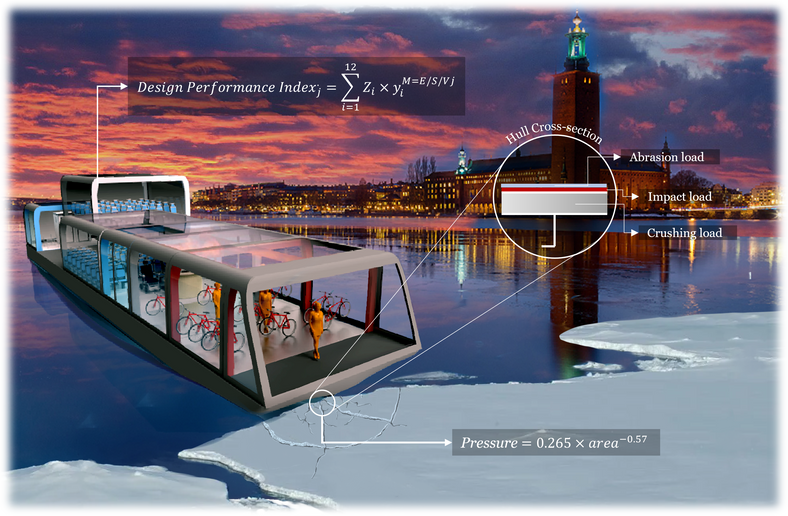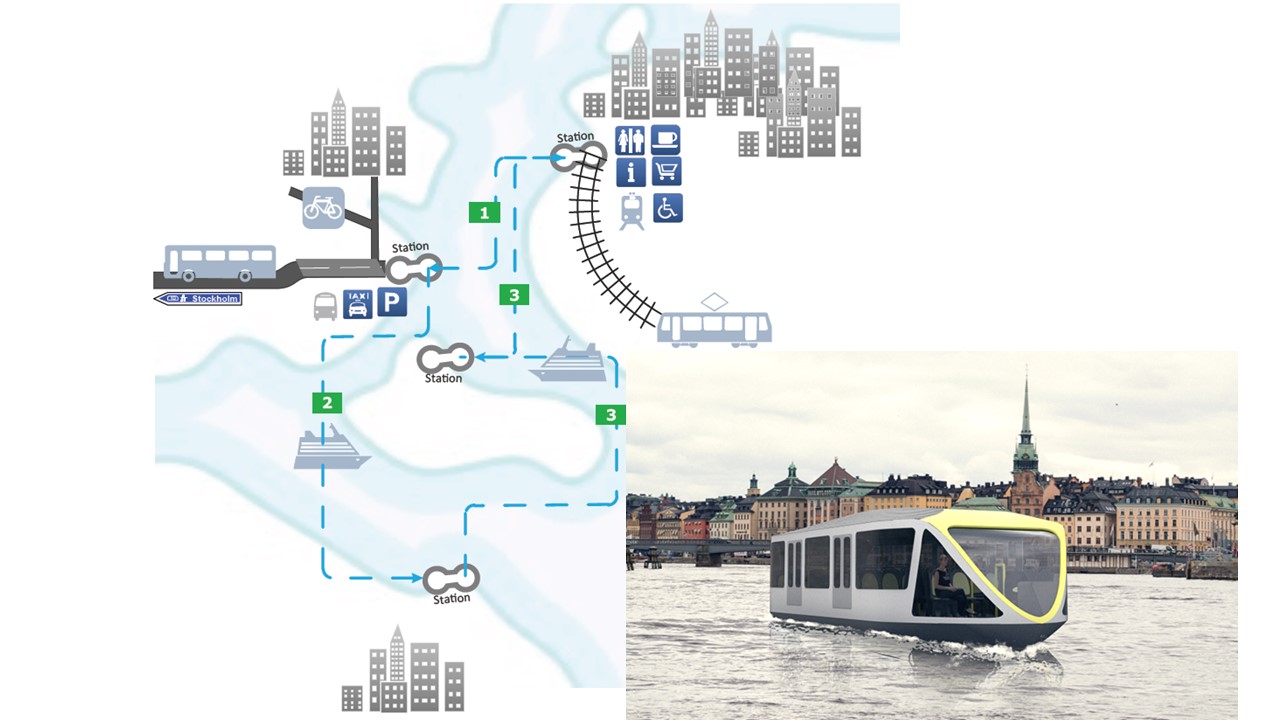WATERBORNE URBAN MOBILITY

På svenska längre ner!
Waterborne public transportation (WPT) is slowly increasing in importance as an active component of public transportation networks in cities. City planners are looking at WPT to overcome urban congestion and pollution. However, prevalent challenges like ferry procurement, poor state of existing ferry fleets and technical challenges like the presence of ice, have created reluctance in the minds of public transport providers (PTPs). While contemporary research shows ferries can be economical and environmentally friendly, there are some fundamental challenges that need to be addressed before PTPs can feel confident.
In this regard, deterrents from PTP’s perspective are identified and solutions are investigated, starting with a systematic characterization of WPT. A definite structure for operational requirements is proposed in an objective manner. Using these as basis, two standard ferry sizes that could fulfil multiple WPT roles in majority of cities are introduced. For establishing city-wise tailoring, platform-architecture based modularization of ferries is proposed. The ferry modules are tailored with respect to operational requirements in a clear and objective manner through the introduction of an evaluation methodology. The method incorporates economic, social, environmental, and regulatory stakeholders. These proposed solutions are aimed at improving PTP’s confidence in WPT and provides solutions for the marine industry to produce quick, cost efficient and tailored ferries.
Next, the scope is focused towards investigating sustainable operations in freshwater ice conditions, typically found in the Stockholm region in Sweden. The ice going ferries today operate with ice strengthened heavy hulls. While they work well in ice, they perform poorly in comparison with non-ice going ferries during ice free months. Correspondingly, solutions towards lightweight ice going hulls are investigated.
This investigation starts with understanding ice-hull interaction mechanisms. Then, techniques to estimate the ice loads are investigated. We adopt a probabilistic approach to tackle the limitations due to the stochastic nature of ice and a lack of experimental data. The resulting load cases are used for evaluating lightweight structural concepts.
The investigation is approached by dividing ice-hull interaction into quasi-static, dynamic and abrasive loading phases. Several candidates corresponding to the first two loading phases are investigated parametrically. The range of structural concepts include metal grillages, bio-inspired composites, and sandwich structures. Realistic loading models for quasi-static and impact mechanisms are developed and validated with experiments. The winning candidates for each loading phase are combined to propose a tri-layer lightweight structural concept. Three candidates for the concept are evaluated and compared.
The thesis answers several questions that riddle WPT today. But at the same time, it raises new questions. Several directions for future work are identified. With continued development, it would be possible to see modularly tailored ferries operating with lightweight hulls in WPT systems around the world.
Results; references to reports and papers at the end of the page!
Vattenburen kollektivtrafik ökar i betydelse som en aktiv komponent i kollektivtrafiknätverk i städer. När trängsel och föroreningar ökar i städerna, börjar stadsplanerare se på vattenvägarna. Men utmaningar när det gäller färjeanskaffning, nergångna befintliga färjeflottor och tekniska utmaningar som is på vintern, har skapat motvilja hos kollektivtrafikleverantörer. Forskning visar att färjor kan vara både ekonomiska och miljövänliga. Inte desto mindre finns det grundläggande utmaningar som måste hanteras innan kollektivtrafikleverantörerna känner tillförsikt. För att möta detta identifieras de avskräckande utmaningarna och lösningar undersöks inledningsvis med att systematiskt karakterisera den vattenburna kollektivtrafiken. En bestämd struktur för verksamhetskrav föreslås med objektiva mått. Med dessa som grund introduceras två standardfärjestorlekar som skulle kunna fylla flera transportroller i städer med vattenvägar. För att möjliggöra skräddarsydda lösningar i olika städer, etableras en mudulariserad plattformsarkitektur för färjorna. Färjemodulerna skräddarsys med hänsyn till operativa krav och granskas objektivt med hjälp av en utvecklad utvärderingsmetodik. Metoden omfattar ekonomiska, sociala, miljömässiga och regelverksaspekter. Metodiken syftar till att förbättra kollektivtrafikleverantörernas förtroende för vattenburen kollektivtrafik och föreslår också lösningar för den marina industrin för snabb produktion av kostnadseffektiva, skräddarsydda färjor.
I nästa steg studeras frågan om hållbar sjötrafik vintertid. Fokus är sötvattenis typisk för Stockholmsregionen i Sverige. De isgående färjorna i trafik idag har isförstärkta tunga skrov. Även om det fungerar bra när det är is, presterar de dåligt i jämförelse med icke-isgående färjor under de isfria månaderna. Detta motiverar utveckling av lätta isgående färjor. Undersökningen inleds med studier av interaktionsmekanismerna mellan is och skrov. Därefter undersöks metoder för att uppskatta isbelastningarna. Här hanteras flera begränsningar, kopplade till brist på experimentell data och isens stokastiska natur, med hjälp av en probabilistisk metod. Metoden tillämpas för att generera designlastfall för undersökning av olika lätta konstruktionskoncept. Undersökningen delar upp is-skrovinteraktionen i kvasistatiska, dynamiska och abrasiva belastningsfaser. Flera kandidater för de två första faserna undersöks parametriskt. Valet av strukturkoncept omfattar metallstrukturer, komposit- och sandwichstrukturer. De är valda utifrån nuvarande designpraxis och med varianter inspirerade från naturen. Realistiska modeller för kvasistatiska- och stötbelastningar utvecklas och valideras med experimentdata. De bästa strukturvarianterna för respektive belastningsfas kombineras till förslag av lättviktskonstruktion i tre lager. Tre sådana strukturvarianter utvärderas och jämförs.
Avhandlingen svarar på flera frågor som idag hämmar vattenburen kollektivtrafik. Den väcker samtidigt nya frågor och flera riktningar för framtida studier identifieras. Slutsatserna belyser möjligheten för modulärt skräddarsydda färjor med lättviktsskrov att operera i den vattenburna kollektivtrafiken runt om i världen.
Project: Waterborne Urban Mobility

The project aims at illustrating modern waterborne commuter vessels, their design and how those year-around units are incorporated in tools for strategic public transport planning. The results contribute to developing the design of standardized smaller and lighter ferries and improving planning tools to assess effects on the transport system from the waterborne mode and its technology development. Main questions are:
- Which ship-type, shape and size is the most beneficial for public transport, considering functionality, manufacturing, operation, maintenance and recycling?
- Which materials and material concepts are best suited to meet this?
- How to assess and compare different multimodal public transport solutions?
The project has three branches:
- Modular ship design
- Lightweight hull design for Nordic conditions
- Simulation-based strategic planning tool for multi-modal (rail-road-sea) public transport systems
The two first result from pre-studies by KTH Centre for naval Architecture and the Stockholm County Council (SLL) in 2016-17. The third is a further development of the Swedish Transport Administration’s MATSim Stockholm model to incorporating the waterborne mode and its terminal solutions and new vessel concepts together with the land borne public transport system and road traffic. The project is presently supported by Swedish Transport Administration, Stockholm County Council and the Swedish maritime competence centre Lighthouse.
Results; references to reports and papers at the end of the page!
Projektet ska visa hur moderna pendelbåtar kan utformas, konstrueras och hur den vattenburna året-runt trafiken kan föras in i den strategiska planeringen av kollektivtrafik. Resultaten ska bidra till utveckling av mindre och lättare tonnage samt av planerings-underlag för att bättre kunna bedöma effekterna av vattenburen kollektivtrafik och av teknikutveckling inför kravställning till upphandling av pendelbåtstonnage. Huvudfrågorna för projektet är:
- Vilken fartygstyp, form och storlek är mest lämpad i kollektivtrafiksystemet med hänsyn till funktionen, tillverkningen, driften, underhållet och återvinningen?
- Vilka material och materialkoncept svarar bäst mot detta?
- Hur bedömer man effektsambanden (t.ex. trängsel, framkomlighet, restid dörr-till-dörr, energieffektivitet, buller, utsläpp, underhålls- och driftskostnader, etc.) mellan olika alternativa kollektivtrafiklösningar i ett multimodalt system (räls-sjö-väg)?
Projektet är uppdelat i tre grenar:
- Modulär fartygsdesign
- Lättviktskrov för nordiska förhållanden
- Simuleringsbaserat planeringsverktyg för multimodala (spår-väg-sjö) kollektivtrafiksystem
De två första är formulerade efter förstudien Hållbart pendel- och skärgårdtonnage som KTH Marina system genomförde i samarbete med Stockholms Läns Landsting, SLL. Den tredje är en vidareutveckling av Trafikverkets modell MATSim Stockholm så att vattenvägen, brygg- och terminallösningar och det nya tonnaget inkorporeras i ett verktyg tillsammans med övrig kollektivtrafik och övrig vägtrafik. Projektet finansieras idag av Trafikverket, Stockholms Läns Landsting och det maritima kompetenscentret Lighthouse.
Results/resultat:
- Cheemakurthy, H., & Garme, K. (2022). A modularly tailored commuter ferry platform. International Shipbuilding Progress, 69, 1–35. https://doi.org/10.3233/isp-210016.
- Cheemakurthy, H., & Garme, K. (2022). Fuzzy AHP-Based Design Performance Index for Evaluation of Ferries. Sustainability, 14(6), 3680–3680. https://doi.org/10.3390/su14063680.
- Zhang, M., Cheemakurthy, H., Ehlers, S., Polach, R. U. F. von B. und, Garme, K., & Burman, M. (2018). Ice Pressure Prediction Based on the Probabilistic Method for Ice-Going Vessels in Inland Waterways. Journal of Offshore Mechanics and Arctic Engineering-Transactions of The Asme, 141(2). https://doi.org/10.1115/1.4041015.
- Cheemakurthy, H., Zhang, M., Garme, K., Burman, M., Ehlers, S., Franz Von Bock, R. U., & Polach. (2018). Statistical estimation of uncertainties associated with ship operations in freshwater ice. Proceedings of the International Offshore and Polar Engineering Conference (ISOPE), 1608–1615. Sapporo. https://onepetro.org/ISOPEIOPEC/proceedings-abstract/ISOPE18/All-ISOPE18/ISOPE-I-18-144/20165.
- Cheemakurthy, H., Barsoum, Z., Burman, M., & Garme, K. (2022). Lightweight Structural Concepts in Bearing Quasi-Static Ice Hull Interaction Loads. Journal of Marine Science and Engineering, 10(3), 416. https://doi.org/10.3390/jmse10030416.
- Cheemakurthy, H., Barsoum, Z., Burman, M., & Garme, K. (2022). Comparison of Lightweight Structural Concepts in Bearing Impact loads during Ice Hull Interaction. Journal of Marine Science and Engineering, 10(6), 794. https://doi.org/10.3390/jmse10060794.
- Cheemakurthy, H., Barsoum, Z., Burman, M., & Garme, K. (2022). A lightweight ice going hull concept for freshwater ice operations. (Manuscript submitted to journal).
- Cheemakurthy, H., Zhang, M., Garme, K., & Barsoum, Z. (2019). Nonlinear Finite Element Analysis of Inland-Waterway Barge in Fresh Water Ice Conditions. Proceedings of The Twenty-Ninth (2019) International Ocean and Polar Engineering Conference (ISOPE), 1, 799–806. Honolulu. https://onepetro.org/ISOPEIOPEC/proceedings-abstract/ISOPE19/All-ISOPE19/ISOPE-I-19-515/21478.
- Cheemakurthy, H., Tanko, M., and Garme, K., 2017 "Urban waterborne public transport systems: An overview of existing operations in world cities," Stockholm, Sweden: KTH Royal Institute of Technology, TRITA-AVE, 978-91-7729-648-5. https://doi.org/10.13140/RG.2.2.32606.69446.
- Tanko, M., Cheemakurthy, H., Hall Kihl, S., & Garme, K. (2019). Water transit passenger perceptions and planning factors: A Swedish perspective. Travel Behaviour & Society, 16, 23–30. https://doi.org/10.1016/j.tbs.2019.02.002.
- Tanko, M., Burke, M., & Cheemakurthy, H. (2018). Water Transit and Ferry-Oriented Development in Sweden: Comparisons with System Trends in Australia. Transportation Research Record, 2672(8), 890–900. https://doi.org/10.1177/0361198118782275.
- Zhang, M., Cheemakurthy, H., Ehlers, S., von Bock und Polach, R. U. F., Garme, K., & Burman, M. (2018). Ice pressure prediction based on the probabilistic method for ice-going vessels in inland waterways. Proceedings of the ASME 2018 37th International Conference on Ocean, Offshore and Arctic Engineering (OMAE): Volume 8. Madrid. https://doi.org/10.1115/OMAE2018-77668.
- Zhang, M., Cheemakurthy, H., Garme, K., & Burman, M. (2019). An Analytical Model for Ice Impact Load Prediction. Proceedings of the International Offshore and Polar Engineering Conference (ISOPE), 807–814. Honolulu. https://onepetro.org/ISOPEIOPEC/proceedings-abstract/ISOPE19/All-ISOPE19/ISOPE-I-19-544/21660.
- Cheemakurthy, H. (2021). Efficient commuter craft for urban waterborne public transportation (Licentiate dissertation, KTH Royal Institute of Technology). Retrieved from http://urn.kb.se/resolve?urn=urn:nbn:se:kth:diva-287834.
- Cheemakurthy, H. (2021). Framework for holistic design of ferries focusing on lightweight ice going hulls (Doctoral dissertation, KTH Royal Institute of Technology). Retrieved from http://kth.diva-portal.org/smash/record.jsf?pid=diva2%3A1694624&dswid=8323